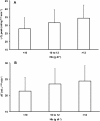Association between preoperative haemoglobin concentration and cardiopulmonary exercise variables: a multicentre study
- PMID: 24472426
- PMCID: PMC3964342
- DOI: 10.1186/2047-0525-2-18
Association between preoperative haemoglobin concentration and cardiopulmonary exercise variables: a multicentre study
Abstract
Background: Preoperative anaemia and low exertional oxygen uptake are both associated with greater postoperative morbidity and mortality. This study reports the association among haemoglobin concentration ([Hb]), peak oxygen uptake (V˙O2 peak) and anaerobic threshold (AT) in elective surgical patients.
Methods: Between 1999 and 2011, preoperative [Hb] and cardiopulmonary exercise tests were recorded in 1,777 preoperative patients in four hospitals. The associations between [Hb], V˙O2 peak and AT were analysed by linear regression and covariance.
Results: In 436 (24.5%) patients, [Hb] was <12 g dl-1 and, in 83 of these, <10 g dl-1. Both AT and V˙O2 peak rose modestly with increasing [Hb] (r2 = 0.24, P <0.0001 and r2 = 0.30, P <0.0001, respectively). After covariate adjustment, an increase in [Hb] of one standard deviation was associated with a 6.7 to 9.7% increase in V˙O2 peak, and a rise of 4.4 to 6.0% in AT. Haemoglobin concentration accounted for 9% and 6% of the variation in V˙O2 peak and AT respectively.
Conclusions: To a modest extent, lower haemoglobin concentrations are independently associated with lower oxygen uptake during preoperative cardiopulmonary exercise testing. It is unknown whether this association is causative.
Figures



Comment in
-
Association of preoperative anaemia with cardiopulmonary exercise capacity and postoperative outcomes in noncardiac surgery: a substudy of the Measurement of Exercise Tolerance before Surgery (METS) Study.Br J Anaesth. 2019 Aug;123(2):161-169. doi: 10.1016/j.bja.2019.04.058. Epub 2019 Jun 19. Br J Anaesth. 2019. PMID: 31227271 Free PMC article.
References
-
- Wasserman K, Koike A. Is the Anaerobic Threshold Truly Anaerobic? Chest. 1992;2(5 Suppl):S211–S218. - PubMed
-
- Brooks GA. Anaerobic threshold: review of the concept and directions for future research. Med Sci Sports Exerc. 1985;2:22–34. - PubMed
-
- Older P, Smith R. Experience with the preoperative invasive measurement of haemodynamic, respiratory and renal function in 100 elderly patients scheduled for major abdominal surgery. Anaesth Intensive Care. 1988;2:389–395. - PubMed
Grants and funding
LinkOut - more resources
Full Text Sources
Other Literature Sources

